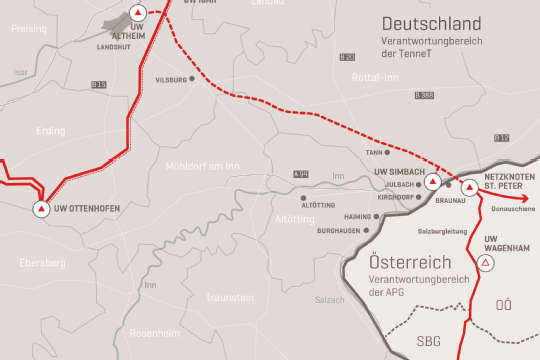
Germany line
A secure and powerful transmission grid represents not only the backbone of the Austrian energy supply, but is also a basic prerequisite for continuing to integrate renewable energy into the grid and for reaching Austrian and European climate protection targets.
Project information
The planned 380-kV line running from the St. Peter node to the German border will make an important contribution to the success of the transition to renewables. The line will combine the renewable energies of wind and water, enabling clean wind power from the north of Europe to be conveyed to the Alpine storage power plants (green batteries). Conversely, the new line will enable optimum use of electricity generated from both existing and new storage power plants, which is primarily drawn upon when there is no or little wind. Without reinforcement from the north-south interconnector between Austria and Bavaria (in Germany), the feasibility of expanding renewable energy in Europe would be called massively into question. Germany’s decision to exit nuclear power also presents new challenges for the Austrian grid.
The 380-kV line running from St.?Peter to the German border (Ottenhofen/Isar/Pleinting) will have four systems and a length of approximately 3?km on the Austrian side (= APG’s project area) and will connect the St.?Peter node, which still has to be modified, to the substations at Simbach, Ottenhofen, Isar and Pleinting in Bavaria. The new 380-kV line will also enable the existing 220-kV lines between St.?Peter and the German border at Simbach/Altheim and St.?Peter and the German border at Pleinting to be dismantled. German transmission grid operator TenneT is in charge of the line system on the German side.
Project ticker
All current information about the project at a glance.
Project ticker
All current information about the project at a glance.
Groundbreaking Ceremony for 380 kV Deutschlandleitung
The Deutschlandleitung (cross-border line between Austria and Germany) is a joint project of the two transmission system operators Austrian Power Grid AG (APG) and TenneT TSO GmbH (TenneT). On March 9, the groundbreaking ceremony for the cross-border construction section took place on the German side.
The new 380 kV Deutschlandleitung will run from St. Peter am Hart (Upper Austria) to Altheim (Bavaria). Approximately 2.5 line kilometers will run on Austrian territory and connect APG's St. Peter grid node with TenneT's Simbach, Ottenhofen, Isar and Pleinting substations in Bavaria. The start of operation of the new 380 kV line, which carries the label ‘Project of common interest’ (PCI) at European level, is scheduled for 2027.
…
Read more in the press release.
Project Roadmap
Start of construction
Detailed geological surveys
EIA approval
EIA approval takes legal effect
Negotiations
Hearings on the Germany line
EIA report
Environmental impact assessment report available for inspection at the EIA authority and in the local communities
Project documents
Project documents available for inspection at the EIA authority and in the local communities
EIA process
Submission of procect to the environmental impact assessment (EIA) process
Environmental Impact Statement (EIS)
Preparation of the Environmental Impact Statement (EIS)
Consultation day for local residents
Second consultation day for local residents at the town hall in St. Peter am Hart
Consultation day for local residents
First consultation day for local residents at the town hall in St. Peter am Hart
Information for local residents
Informational event for local residents at Gasthof Berger in St. Peter am Hart
Approval
Approval for preliminary works
Projects of common interest
European Commission: Projects of Common Interest (PCI)
Having a state-of-the-art infrastructure made up of reliable power grids is crucial to achieving an integrated European energy market, which in turn is essential for being able to provide all consumers with the most cost-effective energy possible. Not only that, but the improvements being made to Europe’s existing network structure to meet the higher demands placed on power grids due to energy generation from renewable sources such as wind and solar will contribute to meeting the 2030 climate targets. To this end, the European Commission on 14 October 2013 adopted a Regulation containing a list of 248 key energy infrastructure projects, including some 140 projects in the field of electricity transmission and storage. Thanks to these projects, the European power grid – and consequently the Austrian power grid – will be able to integrate increasing quantities of electricity from renewable sources of energy, which will enable a significant reduction in CO2 emissions and thus help achieve the EU’s ambitious climate targets.
More information: European Commission Projects of Common Interest
The Germany line received funding from the European Union from the budget for Trans-European Networks for Energy.
Contact person
Marc Kostner
Project lead
Fritz Wöber
Project communication


